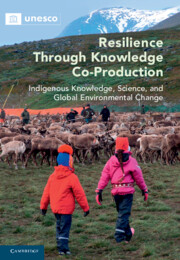 Resilience through Knowledge Co-Production
Resilience through Knowledge Co-Production Book contents
- Resilience through Knowledge Co-production
- Resilience through Knowledge Co-production
- Copyright page
- Contents
- Contributors
- Acknowledgements
- Introduction
- Part I From Practice to Principles
- Part II Indigenous Perspectives on Environmental Change
- Part III Global Change and Indigenous Responses
- 12 Competing Paradigms of Himalayan Climate Change and Adaptations: Indigenous Knowledge versus Economics
- 13 Coping with a Warming Winter Climate in Arctic Russia: Patterns of Extreme Weather Affecting Nenets Reindeer Nomadism
- 14 Rising Above the Flood: Modifications in Agricultural Practices and Livelihood Systems in Central Amazonia – Perspectives from Ribeirinho and Indigenous Communities
- 15 Indigenous Storytelling and Climate Change Adaptation
- 16 Indigenous Knowledge and the Coloniality of Reality: Climate Change Otherwise in the Bolivian Andes
- Epilogue
- Index
- References
12 - Competing Paradigms of Himalayan Climate Change and Adaptations: Indigenous Knowledge versus Economics
from Part III - Global Change and Indigenous Responses
Published online by Cambridge University Press: 02 June 2022
- Resilience through Knowledge Co-production
- Resilience through Knowledge Co-production
- Copyright page
- Contents
- Contributors
- Acknowledgements
- Introduction
- Part I From Practice to Principles
- Part II Indigenous Perspectives on Environmental Change
- Part III Global Change and Indigenous Responses
- 12 Competing Paradigms of Himalayan Climate Change and Adaptations: Indigenous Knowledge versus Economics
- 13 Coping with a Warming Winter Climate in Arctic Russia: Patterns of Extreme Weather Affecting Nenets Reindeer Nomadism
- 14 Rising Above the Flood: Modifications in Agricultural Practices and Livelihood Systems in Central Amazonia – Perspectives from Ribeirinho and Indigenous Communities
- 15 Indigenous Storytelling and Climate Change Adaptation
- 16 Indigenous Knowledge and the Coloniality of Reality: Climate Change Otherwise in the Bolivian Andes
- Epilogue
- Index
- References
Summary
Much of climate change policy treats indigenous peoples (if at all) as hapless victims rather than active participants in all components of climate change research, adaptation, mitigation and policy. Most Tibetans are cognizant of recent, rapid Himalayan climate change including rising temperatures, increasing and unpredictable precipitation, glacial retreat, glacial lake formation and outburst, and altering natural resources. Integrating scientific research with Indigenous knowledge leads to innovative perspectives and solutions. Our 1500 km (900 mile) transect across the eastern Himalaya, with intensive, long-term ecological alpine plant monitoring shows rapidly increasing plant richness, biodiversity and endemism, especially at higher elevations. Traditional ecological knowledge and economic policy often prescribe rival adaptations for Himalayan peoples; traditional culture and economics become competing paradigms by which to analyse the impacts of and adaptations to Himalayan climate change. We have even documented the appropriation and monetisation of successful Indigenous adaptations by government and economic entities to the detriment of the same Indigenous people who developed the strategies.
Keywords
- Type
- Chapter
- Information
- Resilience through Knowledge Co-ProductionIndigenous Knowledge, Science, and Global Environmental Change, pp. 205 - 216Publisher: Cambridge University PressPrint publication year: 2022


